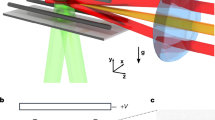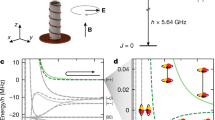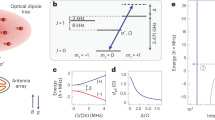Abstract
Ultracold polar molecules offer the possibility of exploring quantum gases with interparticle interactions that are strong, long-range and spatially anisotropic. This is in stark contrast to the much studied dilute gases of ultracold atoms, which have isotropic and extremely short-range (or ‘contact’) interactions. Furthermore, the large electric dipole moment of polar molecules can be tuned using an external electric field; this has a range of applications such as the control of ultracold chemical reactions1, the design of a platform for quantum information processing2,3,4 and the realization of novel quantum many-body systems5,6,7,8. Despite intense experimental efforts aimed at observing the influence of dipoles on ultracold molecules9, only recently have sufficiently high densities been achieved10. Here we report the experimental observation of dipolar collisions in an ultracold molecular gas prepared close to quantum degeneracy. For modest values of an applied electric field, we observe a pronounced increase in the loss rate of fermionic potassium–rubidium molecules due to ultracold chemical reactions. We find that the loss rate has a steep power-law dependence on the induced electric dipole moment, and we show that this dependence can be understood in a relatively simple model based on quantum threshold laws for the scattering of fermionic polar molecules. In addition, we directly observe the spatial anisotropy of the dipolar interaction through measurements of the thermodynamics of the dipolar gas. These results demonstrate how the long-range dipolar interaction can be used for electric-field control of chemical reaction rates in an ultracold gas of polar molecules. Furthermore, the large loss rates in an applied electric field suggest that creating a long-lived ensemble of ultracold polar molecules may require confinement in a two-dimensional trap geometry to suppress the influence of the attractive, ‘head-to-tail’, dipolar interactions11,12,13,14.
This is a preview of subscription content, access via your institution
Access options
Subscribe to this journal
Receive 51 print issues and online access
$199.00 per year
only $3.90 per issue
Buy this article
- Purchase on Springer Link
- Instant access to full article PDF
Prices may be subject to local taxes which are calculated during checkout


 /
/  n , as a function of dipole moment.
n , as a function of dipole moment.

Similar content being viewed by others
References
Krems, R. V. Cold controlled chemistry. Phys. Chem. Chem. Phys. 10, 4079–4092 (2008)
DeMille, D. Quantum computation with trapped polar molecules. Phys. Rev. Lett. 88, 067901 (2002)
Andre, A. et al. A coherent all-electrical interface between polar molecules and mesoscopic superconducting resonators. Nature Phys. 2, 636–642 (2006)
Yelin, S. F., Kirby, K. & Côte, R. Schemes for robust quantum computation with polar molecules. Phys. Rev. A 74, 050301 (2006)
Micheli, A., Brennen, G. K. & Zoller, P. A toolbox for lattice-spin models with polar molecules. Nature Phys. 2, 341–347 (2006)
Lahaye, T., Menotti, C., Santos, L., Lewenstein, M. & Pfau, T. The physics of dipolar bosonic quantum gases. Rep. Prog. Phys. 72, 126401 (2009)
Pupillo, G., Micheli, A., Büchler, H. P. & Zoller, P. in Cold Molecules: Theory, Experiment, Applications (eds Krems, R. V., Stwalley, W. C. & Friedrich, B.) 421–469 (CRC, 2009)
Baranov, M. Theoretical progress in many-body physics with ultracold dipolar gases. Phys. Rep. 464, 71–111 (2008)
Carr, L. D., DeMille, D., Krems, R. V. & Ye, J. . Cold and ultracold molecules: science, technology and applications. N. J. Phys. 11, 055049 (2009)
Ni, K.-K. et al. A high-phase-space-density gas of polar molecules. Science 322, 231–235 (2008)
Micheli, A. et al. Cold polar molecules in two-dimensional traps: tailoring interactions with external fields for novel quantum phases. Phys. Rev. A 76, 043604 (2007)
Büchler, H. P. et al. Strongly correlated 2D quantum phases with cold polar molecules: controlling the shape of the interaction potential. Phys. Rev. Lett. 98, 060404 (2007)
Li, Z. & Krems, R. V. Inelastic collisions in an ultracold quasi-two-dimensional gas. Phys. Rev. A 79, 050701 (2009)
Quéméner, G. & Bohn, J. L. Strong dependence of ultracold chemical rates on electric dipole moments. Phys. Rev. A 81, 022702 (2010)
Stuhler, J. et al. Observation of dipole-dipole interaction in a degenerate quantum gas. Phys. Rev. Lett. 95, 150406 (2005)
Vengalattore, M. et al. Spontaneously modulated spin textures in a dipolar spinor Bose-Einstein condensate. Phys. Rev. Lett. 100, 170403 (2008)
Gral, K., Santos, L. & Lewenstein, M. Quantum phases of dipolar bosons in optical lattices. Phys. Rev. Lett. 88, 170406 (2002)
Capogrosso-Sansone, B., Trefzger, C., Lewenstein, M., Zoller, P. & Pupillo, G. Quantum phases of cold polar molecules in 2D optical lattices. Phys. Rev. Lett. (in the press); preprint at 〈http://arxiv.org/abs/0906.2009〉 (2009)
Pollet, L., Picon, J. D., Büchler, H. P. & Troyer, M. Supersolid phase with cold polar molecules on a triangular lattice. Preprint at 〈http://arxiv.org/abs/0906.2126〉 (2009)
Cooper, N. R. & Shlyapnikov, G. V. Stable topological superfluid phase of ultracold polar fermionic molecules. Phys. Rev. Lett. 103, 155302 (2009)
Ospelkaus, S. et al. Controlling the hyperfine state of rovibronic ground state polar molecules. Phys. Rev. Lett. 104, 030402 (2010)
Ospelkaus, S. et al. Quantum-state controlled chemical reactions of ultracold potassium-rubidium molecules. Science 327, 853–857 (2010)
Masuhara, N. et al. Evaporative cooling of spin-polarized atomic hydrogen. Phys. Rev. Lett. 61, 935–938 (1988)
Monroe, C. R., Cornell, E. A., Sackett, C. A., Myatt, C. J. & Wieman, C. E. Measurement of Cs-Cs elastic scattering at T = 30 µK. Phys. Rev. Lett. 70, 414–417 (1993)
Bohn, J. L., Cavagnero, M. & Ticknor, C. Quasi-universal dipolar scattering in cold and ultracold gases. N. J. Phys. 11, 055039 (2009)
Gorshkov, A. V. et al. Suppression of inelastic collisions between polar molecules with a repulsive shield. Phys. Rev. Lett. 101, 073201 (2008)
Wang, D. W., Lukin, M. D. & Demler, E. Quantum fluids of self-assembled chains of polar molecules. Phys. Rev. Lett. 97, 180413 (2006)
Klawunn, M., Duhme, J. & Santos, L. Bose-Fermi mixtures of self-assembled filaments of fermionic polar molecules. Phys. Rev. A 81, 013604 (2010)
DeMarco, B., Bohn, J. L., Burke, J. P. Jr, Holland, M. H. & Jin, D. S. Measurement of p-wave threshold law using evaporatively cooled fermionic atoms. Phys. Rev. Lett. 82, 4208–4211 (1999)
Kotochigova, S. Dispersion interactions and reactive collisions of ultracold polar molecules. Preprint at 〈http://arxiv.org/abs/1003.2672〉 (2010)
Acknowledgements
This work was supported by the US National Institute of Standards and Technology programme Innovations in Measurement Science–Ultracold Stable Molecules, the US National Science Foundation (NSF) Physics Frontier Center at JILA, the US Department of Energy, Air Force Office of Scientific Research Multidisciplinary Research Initiative on Ultracold Molecules, and a NSF graduate fellowship (B.N.).
Author information
Authors and Affiliations
Contributions
The experimental work and data analysis were done by K.-K.N., S.O., D.W., B.N., M.H.G.M., J.Y. and D.S.J. Theoretical calculations of the inelastic loss rates were done by G.Q. and J.L.B.
Corresponding authors
Ethics declarations
Competing interests
The authors declare no competing financial interests.
Supplementary information
Supplementary Information
This file contains Supplementary Information and Data comprising: Heating due to two-body inelastic p-wave collisions. (PDF 82 kb)
Rights and permissions
About this article
Cite this article
Ni, KK., Ospelkaus, S., Wang, D. et al. Dipolar collisions of polar molecules in the quantum regime. Nature 464, 1324–1328 (2010). https://doi.org/10.1038/nature08953
Received:
Accepted:
Published:
Issue Date:
DOI: https://doi.org/10.1038/nature08953
This article is cited by
-
Field-linked resonances of polar molecules
Nature (2023)
-
Collisionally stable gas of bosonic dipolar ground-state molecules
Nature Physics (2023)
-
Enhancing reactivity of SiO+ ions by controlled excitation to extreme rotational states
Nature Communications (2023)
-
Itinerant ferromagnetism entrenched by the anisotropy of spin–orbit coupling in a dipolar Fermi gas
Frontiers of Physics (2023)
-
Evaporation of microwave-shielded polar molecules to quantum degeneracy
Nature (2022)
Comments
By submitting a comment you agree to abide by our Terms and Community Guidelines. If you find something abusive or that does not comply with our terms or guidelines please flag it as inappropriate.



